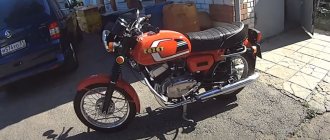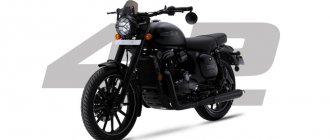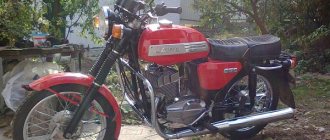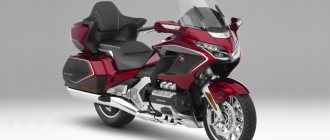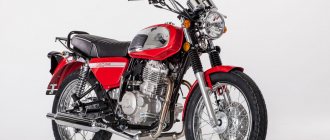Motorcycle technology has always been considered one of the favorites of most men. In the Soviet Union, the motorcycle played an important role in the lives of many people, so famous factories produced new models with different characteristics, appearance and design. Today, Soviet motorcycles have gone far into history, but motorcycles from famous brands of the USSR are still actively used and receive a number of praises. Any adult man knows such names as Izh, Ural, Java, Minsk or Dnepr. These are all legendary models, which at one time were produced in huge quantities.
Soviet motorcycles received a worldwide vocation due to their ease of use, accessibility for most citizens and versatility. After all, not many models were produced, which means that any beginner in this field could repair them. Depending on the class of the motorcycle, it was intended for the following purposes:
- fast driving in the city and on the highway;
- transportation of large and heavy cargo;
- use in agriculture.
History of the creation of motorcycles in the USSR
Previously, the Soviet motorcycle was considered a real symbol of good feelings and joy, because it was used for various purposes - riding girls, visiting a maternity hospital, transporting potatoes from the field, riding with friends, and so on. Current motorcycles in Russia and other countries were created by well-known foreign companies, but do not forget about the legends of past years, which even today in some ways are superior to certain new products.
The history of world motorcycle technology begins in 1902, when the famous engineer Leitner decided to install a 430 cc engine on a bicycle. The maximum speed then did not exceed 35 km/h. Until 1923, the Soviet motorcycle fleet consisted of only foreign models, but after that engineer Lvov decided to create the first Soyuz motorcycle. A couple of years later, namely in 1928, a more famous motorcycle called Izh was mass-produced. Every year, Soviet motorcycles improved, but in some characteristics they were inconvenient or inferior to foreign models. The then IZH models of the 20s had a quite good engine, which reached a volume of 1,200 cubic meters. cm and produced a power of 25 horses. Even its heavy weight of 290 kg did not prevent it from accelerating well and feeling great on the road.
But over time, new models appeared that won millions of hearts. The best of them were designed and produced at the Izhevsk, Minsk, Kiev and Kovrov factories. We offer several of the most famous and first motorcycle models of the USSR, which are still known today.
L-300
One of the very first production motorcycles, which was produced since 1930. Unfortunately, this is not a proprietary development of the USSR; the German DKW Luxus 300 was taken as the basis. Unfortunately, the production of the model lasted only 8 years, but enough copies were produced. Subsequently, the model was used on such a motorcycle as the Izh-8.
The technical data of the L-300 were impressive for that time. The engine had a volume of 300 cubic meters and up to 3,000 rpm. The power was only 6 horsepower, and the maximum speed was limited to 80 km/h. With a light weight of only 125 kg, motorcycles could consume an average of 4.5 liters per hundred. The motorcycle was produced at the Red October enterprise.
Specifications
The IZHB-47 double-barreled hammerless shotgun had the following performance characteristics:
- Caliber: 12, 16, 20.
- Steel: 50A Izhevsk plant.
- Drilling: right barrel - half, left barrel - choke.
- Barrel length: 700 mm.
- Chuck length: 70.1 mm.
- The length of the gun is 1130 mm.
- Gun weight: from 3 to 3.2 kg.
- Barrel weight: 1.5 kg.
- Stock: with pistol head.
- Diameter of strikers: 2.5 mm
- Angle of inclination of the firing pins relative to the axis of the bore: no.
- Protrusion of the striker from the block shield: not allowed.
- Trigger force on the front trigger: 1.5-2.7 kg.
- rear: 1.7-3.0 kg.
| Caliber | 12, 16, 20 |
| Weight, kg | up to 3.2 |
| Chamber length | 70 |
| Diameter of strikers, mm | 2,5 |
| Barrel length, mm | 700 |
| Trigger force, kg | front trigger 1.5-2.7; rear 1.7-3 |
Manufactured with drilled barrels. Indicates the method of drilling the stamp. For example, “18.2/17.4” - the choke has a diameter (left barrel) of 17.4 mm, bore - 18.2 mm.
The shooting results are also displayed with marks. When studying these indicators, you must first of all pay attention to the fact that there is no stamp with working pressure parameters; these data are recorded in the passport.
Ural M-62
The presented model belongs to the class of heavy motorcycles; its production lasted later, namely in the period from 1961 to 1965. The Ural M-62 was produced by the Ibrit motorcycle plant. The main advantages of the model include:
- the presence of a more modern gearbox;
- engine power and reliability have improved (up to 28 hp);
- suspension travel has increased slightly;
- good speed with heavy weight.
With a considerable weight of 255 kg, engineers were able to design an engine with a maximum speed of 95 km/h. The Ural M-62 was equipped with a sidecar and consumed an average of 6 liters per hundred. Subsequently, another improved model M-72 was released.
Minsk M1A
The most famous Soviet motorcycles in that country, Minsk, were produced in Belarus. They were the best model for many years and remain one of my favorites to this day. But the history of creation began with the first model - Minsk M1A, which, according to rumors, was designed in the image of the German DKW RT125. The first production of the model dates back to 1951. Of all the Minsk models, about 6.5 million copies were sold around the world and the former USSR.
Like most Soviet models, this bike had a simple and reliable design and was very easy to repair. The model's engine had a volume of 125 cubic meters and was quite playful.
The first years of the USSR
The first attempts to restore work, which was actually the pioneer of the motorcycle industry before the revolution, were not made soon. In 1918, the enterprise was renamed “State Aviation Plant No. 1” and focused on the production of aircraft parts, railcars and other products.
The plant tried to return to its usual course in 1924, when a group of engineers developed and built on it the very first Soviet motorcycle, which received the symbolic name “Soyuz”. In comparison with the models produced in 1910-14, this was a confident step forward. Firstly, the car was built on the basis of a single-cylinder 4-stroke 503 “cc” engine and even had a soft suspension on both wheels, a multi-plate clutch and a three-speed gearbox. And, secondly, unlike its predecessors, it consisted almost entirely of domestic parts. The only exceptions were the magneto and carburetor, but even the engine was designed and manufactured in the Soviet Union.
In general, the development turned out to be successful and even quite successfully participated in the “Second Test Automobile Rally”, which took place in 1925, but for some reason it never went into mass production.
Izh Planet Sport
The production of this legend was carried out by the Izhevsk Motor Plant, which first showed the new product in 1973. During its creation, special emphasis was placed on speed, so for the Soviet racer it was a real “Sport”. In appearance, we can say that the model was distinguished by a slightly sporty design, taken from foreign models of the 60s.
Over the long period of production, Izh Planet Sport was produced in huge quantities and was later exported to other countries. The main feature was, of course, the maximum speed, which was up to 140 km/h.
As a conclusion
Affordable hunting weapons, albeit without outstanding characteristics, greatly helped to establish post-war life. This was especially true in rural and suburban areas, where the hunter’s catch became a significant help in the economy.
A few years later, when the domestic industry reached its previous level, the first post-war models were replaced by new developments. Production of IZH-47B was discontinued.
By the seventies, Izhevsk models from the forties were considered just old guns, and after half a century they became collectible.
Currently, all types of IZH-47B, and not just the rare 12 and 20 gauges, are in great demand. Like everything made under Comrade Stalin, it is in great demand among connoisseurs. However, it should be understood that the collectability of a gun is greatly influenced by the authenticity of the existing weapon.
The highest prices are for copies in which not a single part has been replaced, there is a passport, receipts, and, when fully complete, a sales receipt. In such cases, we can talk about thousands of dollars. Grandfather’s loose IZHB-47 with changed locks has a price, of course, but you can’t sell it for that money. The more non-original parts there are, the worse the condition of the remaining ones, the less collectible value there will be.
The 1947 IZHB-47 beskurkovka was produced in small quantities. Out of several tens of thousands, only a few barrels have survived to this day, and they do not appear on the market very often. Therefore, a copy of IZHB-47 can become, if not a decoration, but quite a worthy part of a firearms collection.
On our secondary market, the IZHB-47 horizontal gun is very rare; it is an absolute rarity and the subject of persistent search for collectors of domestic hunting weapons, despite the external roughness of the forms and laconic decor.
Jawa 360
Later Soviet times speak of the era of Java fans. In the 70s, it was one of the best motorcycles, on which every third Soviet biker rode. The manufacturer itself has produced more than 1 million copies, which have won the hearts of thousands of people. The most beautiful, reliable and powerful was the Jawa 360.
The most interesting modifications were considered to be those with a side stroller, a chrome-plated gas tank and a rich red color. Depending on the modification, engines of 250 and 350 cc were distinguished. The engine on the Java 350 was playful and powerful, it was not for nothing that the saying went “If you bought a Java, dig a hole.”
Advantages and disadvantages of IZHB-47
The pre-war model IZH-36, the design of which formed the basis for the IZH-47, had a number of disadvantages. In particular, poor balance, non-ergonomic butt and stock, and an unsuccessful cocking system. The IZH-46 and IZH-47 shotguns, which were modified models of the 1936 model, gradually freed the hammerless shotgun from such inconveniences.
Products of that time were characterized by deviations from the technological cycle: both in the manufacture of individual parts and in the assembly of finished units. Fans of collectible hunting weapons are often perplexed: in Izhevsk guns produced in 1945-1947, there are many parts with inappropriate markings.
This situation arose due to the use of non-standard parts that were located in the warehouses of arms factories. These parts were used during assembly and were not always fully compatible with each other. There were also other technical difficulties.
For example, the production of IZH-47 analogues in Ukraine was stopped due to a high percentage of defects.
Gradually, gunsmiths got rid of the main shortcomings. The 1947 model was already fully mass-produced, observing all the features of the technology.
Old models, including IZH-47B, have earned a reputation among hunters as reliable, simple and unpretentious weapons.
This gun found excellent use in remote areas where there was no developed repair base. Being able to fix the gun in a regular mechanic shop was a huge plus. The main advantage of the gun was its mass production, which helped saturate the market.
Dnepr 11
And this model of Soviet motorcycles, although universal in design and operation, was in greatest demand among “rockers.” The first Soviet bikers considered the Dnepr 11 one of the best; the motorcycle was produced in Kyiv.
The design of the motorcycle is simple and easy to repair; most also tried to tune the model, which was quite possible with little effort. An interesting fact is that Soviet Dnepr 11 motorcycles can still be found on the roads in working condition.
How are Soviet bikes used now?
Nowadays, retro motorcycles of the USSR can be seen both in museums and on public roads. They have hardly lost their popularity and are still used in agriculture, and young people get their first driving experience . Of course, the harsh conditions of use of those times do not allow finding a unit in excellent condition, and the technical part of Russian production has always left much to be desired. However, Soviet motorcycles are still running and even look quite tolerable.
In general, USSR motorcycles are in no way inferior, and in many ways even superior to foreign manufacturers. Not every foreign car can boast cross-country capability of the Dnieper or the Urals. Moreover, motorcycle spare parts are always easy to find and repair yourself.
For many people, Soviet units will always be more in demand than others. After all, we not only worked and went on vacation with them, but also won wars. Nowadays there are many collectors who collect the rarest motorcycle models. By restoring them, they achieve maximum proximity to the original. You've probably seen a very old bike with an excellent appearance more than once. A trip on such a unit across Russia evokes among insiders not only admiration for the device, but also respect for its owner.


